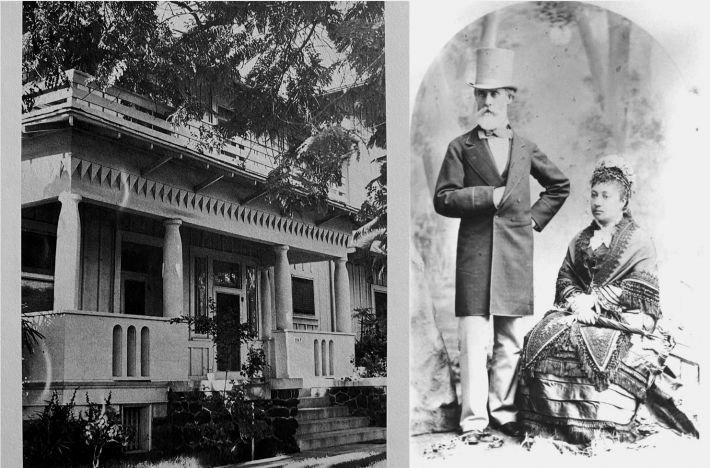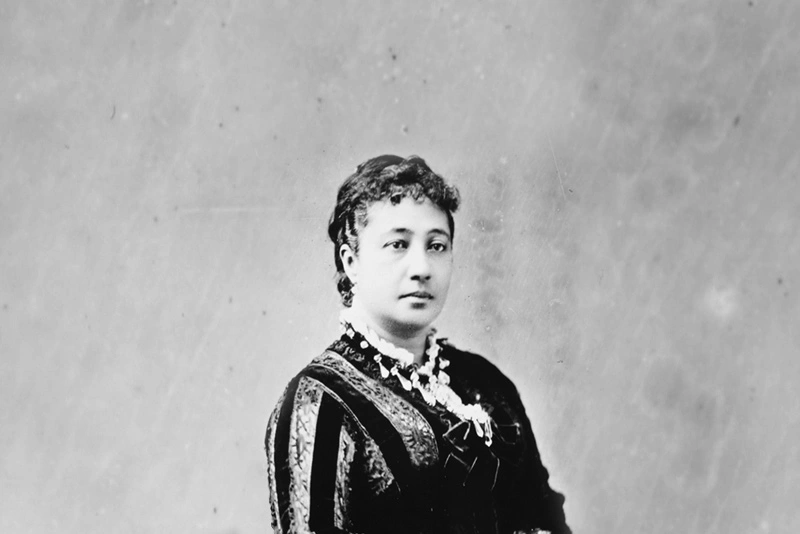In this Kūkahekahe, we celebrate the birth and life of Princess Kaʻiulani, who was treated as a “favorite niece” by our own Charles Reed Bishop. Bishop’s love of his wife Pauahi and of Kaʻiulani led to the establishment of important institutions that served the young women of this lāhui.
Aloha lā hānau e ka hoʻoilina mōʻī wahine Kaʻiulani!
Victoria Kaʻiulani Kawekiu I Lunalilo Kalaninuiahilapalapa Cleghorn was born on October 16, 1875. She was the only child of Princess Miriam Likelike, who was the sister to King Kalākaua and Queen Liliʻuokalani. Her father, Archibald Scott Cleghorn, was a Scottish businessman. At the age of 15, Kaʻiulani was proclaimed Crown Princess of Hawaiʻi by Queen Liliʻuokalani and was a future ruler of Hawaiʻi.
Princess Kaʻiulani was beloved by all. One of her godmothers, Princess Ruth Keʻelikōlani, gave her the famed Waikīkī estate, ‘Āinahau, as a birthday gift, and she was the self-proclaimed “favorite niece” of Mr. Charles Reed Bishop, husband of Ke Aliʻi Bernice Pauahi Bishop. Her aunt, Princess Pauahi, had passed away on Kaʻiulani’s birthday in 1884. In the months after Queen Liliʻuokalani was overthrown in 1893, Mr. Bishop, Cleghorn, and her kahu, Theophilus Davies, tried to get Kaʻiulani on the throne as a compromise with the newly self-instated Provisional Government in order to maintain Hawaiian leadership in the islands, to no avail.
Although it was widely known that Kaʻiulani was a punahele, a favorite of Mr. Bishop, it is not common knowledge that her doting uncle presented all of Ke Aliʻi Pauahi’s jewelry to Kaʻiulani for her to use as her dowry. Princess Kaʻiulani selected a few pieces to wear and placed the others in storage for safe keeping. At the tragic death of the Kaʻiulani in 1899, Cleghorn offered to do anything with the jewels that Mr. Bishop wanted. This offer drew forth the request that they be placed safely in the Bishop Museum with cards stating how and why they came to be there.
The Bishop Museum built on the original Kamehameha Schools campus at Kaiwiʻula in honor of the School’s founder was always meant to be for nā pua a Pauahi, a place for future generations of Hawaiians to kahu, steward, and draw strength from those treasured emblems of heritage. Upon its completion, Mr. Bishop wrote to Princess Kaʻiulani, on April 7, 1892:
“I think you will be pleased with the little museum at the Kamehameha Schools. Its name is the ‘Bernice P. Bishop Museum’ – and contains only things belonging to the Pacific Islands. When your old ‘uncle’ is dead and gone, I hope that you will continue to take an interest in it for the sake of your dear friend and ‘aunt’ whose name it bears, and because of the love for her and for Hawaii nei which led to its establishment.”
Kamehameha Schools itself was to be a malu, a puʻuhonua, a place of protection and support and to prepare for hard-earned opportunities that would help one become the best version of oneself. The Boys School had been running for nearly two-decades and the Girls School for eleven years when the Girls School Principal, Miss Ida Pope, sent a request to Mr. Bishop. She discussed the urgent need to provide living quarters for those among her graduates who had transitioned into the workforce and who were going to business college or normal school (to become teachers), but who had not yet married, nor had family to stay with. Because of strictures at the time, it was not socially acceptable for young women to live on their own or even to be employed without proper guardianship.
To support the young Hawaiian graduates, Mr. Bishop established the Kaʻiulani Home for Girls. It would be funded through the Kaʻiulani Trust, which he established in the name of his beloved niece, under the auspices of his own Charles Reed Bishop Trust.
On April 24, 1903, Bishop addressed Mr. Joseph O. Carter, a Bernice Pauahi Bishop Estate trustee and one of the early directors of the Bishop Museum:
“A late letter from Miss Pope telling me of the steps taken towards opening a new Home for girls graduating from the boarding and Normal Schools, who intend to work for an honest living pleases me very much and I have had a little talk with Mrs. Henry Waterhouse, who is enthusiastic on the subject. Such good women as Mrs. F.W. Macfarlane, Mrs. S.C. Allen and others of their class cannot do a more useful thing to their race and the community than to stir up an interest in such girls and such a safe home for them, until they can have other homes and protectors.”
Rooted in aloha for Pauahi and Kaʻiulani, Bishop’s interest in the well-being of young Hawaiian women helped to elevate them during a time when many young women struggled and were limited in achievement by the mores of society. He supported many enterprises devoted to them, and the Kaʻiulani Home was one of the best examples. A little later, on May 25, 1905, Bishop wrote again to Carter:
“You know how greatly Hawaiian girls need friends and protectors after they leave the schools in which they have been educated…It seems desirable and important that the Kaiulani Home for young women should be enlarged to accommodate a greater number and have a suitable building of its own convenient locality and clear of debt or rent so as to establish it on a more permanent basis…This object must appeal strongly to the good women of the Islands and the management should be entirely in their hands…I have had some conversation and correspondence with Miss Pope on this subject, and they know what I am willing to do.”
He subsequently offered to give an extra $5,000 for the expansion to a group of civic-minded women under the leadership of Miss Pope on August 28, 1905, if they were able to raise $15,000 by October 1, 1905. The funds were raised, and the Kaʻiulani Home for Girls was opened October 16 and chartered December 15, 1905, at the Hopper Estate (presently the site of the Hawaiʻi State Library). Two years later, a nearby site adjacent to the first mission homes, and where the Hale Mauka building of our Kamehameha Schools Kawaiahaʻo Plaza offices stands today, was established at the cost of $25,000.00. Bishop also remembered the home in his preparation of the Charles R. Bishop Trust Deed. He authorized under the direction of the Trustees, a maximum annual payment of $1000 for the term of the trust. Kamehameha Schools was granted the temporary full use of the property and income of the Kaʻiulani Trust in 1950 for the purpose of housing Kamehameha girls as boarding students, thus ending Mr. Bishop’s perpetual $1000 payments.
In the young women of Hawaiʻi, Charles Reed Bishop saw the same aloha and spirit he saw in his own favorite niece Kaʻiulani and his beloved wife Pauahi. The work to establish institutions that served the lāhui in their names was perhaps the greatest testament to these aliʻi wahine.

Left: The Kaʻiulani Home on King Street, which was located where Kawaiahaʻo Plaza is located today (D. Mitchell “Kū Kilakila o Kamehameha,” 1993) Right: Charles Reed Bishop and Princess Bernice Pauahi Bishop in San Francisco, 1875. Photo: Kamehameha Schools Archives.
TAGS
kūkahekahe,charles reed bishop,princess kaʻiulani
CATEGORIES
Kaipuolono Article, Regions, Themes, Culture, Community, Hawaii Newsroom, KS Hawaii Home, Kapalama Newsroom, Kapalama Home, Maui Newsroom, KS Maui Home, Newsroom, Campus Programs, Hawaii, Kapalama, Maui, Community Education, Hawaii campus, Kapalama campus, Maui campus
Print with photos
Print text only










